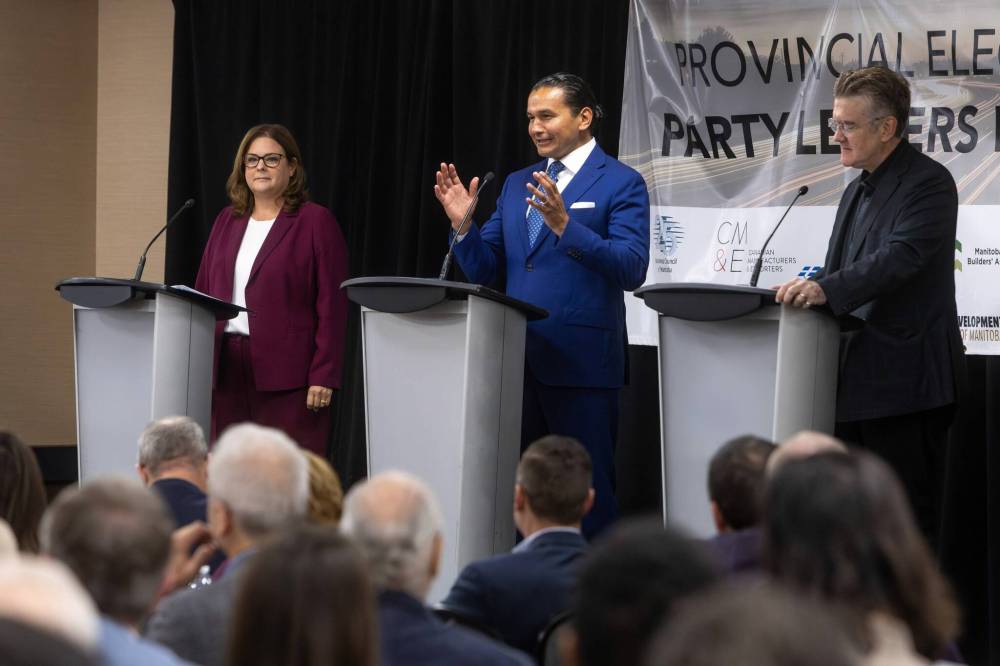No winners in the provincial-election blame game
Advertisement
Read this article for free:
or
Already have an account? Log in here »
To continue reading, please subscribe:
Monthly Digital Subscription
$0 for the first 4 weeks*
- Enjoy unlimited reading on winnipegfreepress.com
- Read the E-Edition, our digital replica newspaper
- Access News Break, our award-winning app
- Play interactive puzzles
*No charge for 4 weeks then price increases to the regular rate of $19.00 plus GST every four weeks. Offer available to new and qualified returning subscribers only. Cancel any time.
Monthly Digital Subscription
$4.75/week*
- Enjoy unlimited reading on winnipegfreepress.com
- Read the E-Edition, our digital replica newspaper
- Access News Break, our award-winning app
- Play interactive puzzles
*Billed as $19 plus GST every four weeks. Cancel any time.
To continue reading, please subscribe:
Add Free Press access to your Brandon Sun subscription for only an additional
$1 for the first 4 weeks*
*Your next subscription payment will increase by $1.00 and you will be charged $16.99 plus GST for four weeks. After four weeks, your payment will increase to $23.99 plus GST every four weeks.
Read unlimited articles for free today:
or
Already have an account? Log in here »
Hey there, time traveller!
This article was published 18/09/2023 (808 days ago), so information in it may no longer be current.
Welcome to another edition of every voter’s least-favourite reality show: the Manitoba provincial election health-care blame game.
On one side, we’ve got New Democratic Party Leader Wab Kinew, who is racing around the province telling voters that since being elected in 2016, the Progressive Conservative government has broken the health-care system through a combination of austerity and insensitivity.
But wait — before deciding who to vote for, you also need to listen to PC Leader Heather Stefanson, who will tell you her party inherited a health-care system that was already broken from the former NDP government and, having had only seven years in office — several of which were impacted by the COVID-19 pandemic — she hasn’t had a fair chance to get things back on track.

MIKE DEAL / WINNIPEG FREE PRESS FILES
Premier Heather Stefanson (PC), Opposition Leader Wab Kinew (NDP) and Liberal Leader Dougald Lamont.
And finally, we’ve got Liberal Leader Dougald Lamont, who — like a disapproving parent watching two toddlers throwing sand at each other — warns that both parties have their fingerprints all over the health-care crisis we’re currently suffering through.
In case it wasn’t already clear from the tone of the debate above, there are no real winners in the Manitoba provincial election blame game, just a lot of voters suffering from the same throbbing headache.
Such is the fate of voters in a province in which only two parties have any realistic chance of governing. In fact, this year marks the 70th anniversary of the last time a party other than the Progressive Conservatives or NDP won a provincial general election.
A Liberal-Progressive coalition dominated Manitoba politics for nearly 20 years prior to PC premier Duff Roblin’s 1958 minority win. Since then, control of the legislature has been strictly Tory blue or NDP orange.
Seven decades of power held by just two parties means there is simply no way to avoid having Tories and New Democrats blame each other for every problem facing the province. In keeping with that tradition, the ghosts of former premiers and governments hang heavily in the air of this campaign, particularly when health care is the issue of debate.
This year marks the 70th anniversary of the last time a party other than the Progressive Conservatives or NDP won a provincial general election.
For the PCs, the ghost Stefanson constantly summons is that of former NDP premier Greg Selinger, who took over from Gary Doer in 2009 and then won a majority mandate in the 2011 general election.
Selinger governed through some pretty tough times, taking over the reins from Doer in the wake of the 2008 global financial meltdown. The flattening of provincial revenues, including a profound levelling-off of federal transfer payments, left Selinger in a tight spot.
The beginning of the end of Selinger’s political career came when he broke an earlier promise and increased the PST to fund infrastructure, prompting members of his own cabinet and caucus to try to force him out office. Like the controlled demolition of an old Las Vegas hotel, Selinger’s government collapsed into a dusty pile of rubble, giving PC leader Brian Pallister a huge majority after the 2016 election.
Did Pallister inherit a health-care system so afflicted that it could not be fixed in the seven years the Tories have been in power?
There is no doubt Selinger created a mess inside his own party, but it’s hard to say specifically that he undermined health care.
It is absolutely true that many of the problems we see today in health care — surgical and diagnostic wait times, physician and nurse shortages, a chronic under-supply of home care and personal care beds — were evident when the NDP was in power.
But it’s equally true the Pallister Tories came in and made a worrisome situation much worse. And that Stefanson, with only two years as first minister under her belt, has been unable to undo all that Pallister wrought.
After coming to power, Pallister immediately choked off increases to health-care funding. He also introduced a controversial plan — conceived by a consultant hired by the NDP — to reduce the number of hospital ERs in Winnipeg.
More importantly, the thinly veiled contempt Pallister had for health-care unions would ultimately undermine many of his so-called reforms. As relations grew increasingly caustic, more health-care professionals either left the province, retired or — as has been the case with many nurses — went to work in the private sector.
Pallister wagered he could essentially freeze health-care funding in order to create the fiscal room to balance the budget and introduce massive tax cuts. The (briefly) balanced budget and tax cuts certainly appeared; after the pandemic struck, however, Pallister’s risky wager could only produce a jackpot of fool’s gold.
The (briefly) balanced budget and tax cuts certainly appeared; after the pandemic struck, however, Pallister’s risky wager could only produce a jackpot of fool’s gold.
So, who wins the blame game? The final word goes to Lamont, our third contestant and the man least likely to awaken on Oct. 4 with a chance to form government.
In the leaders’ debate broadcast on CJOB on Monday, Lamont correctly noted that both the NDP and Tories have their fingerprints on the problems in health care. And then, in an act of completely justifiable self-interest, he offered this observation:
“(Both the NDP and Tories) have done nothing to deserve your vote.”
Lamont may have no chance to win the election, but he comes out on top in the blame game.
dan.lett@winnipegfreepress.com

Dan Lett is a columnist for the Free Press, providing opinion and commentary on politics in Winnipeg and beyond. Born and raised in Toronto, Dan joined the Free Press in 1986. Read more about Dan.
Dan’s columns are built on facts and reactions, but offer his personal views through arguments and analysis. The Free Press’ editing team reviews Dan’s columns before they are posted online or published in print — part of the our tradition, since 1872, of producing reliable independent journalism. Read more about Free Press’s history and mandate, and learn how our newsroom operates.
Our newsroom depends on a growing audience of readers to power our journalism. If you are not a paid reader, please consider becoming a subscriber.
Our newsroom depends on its audience of readers to power our journalism. Thank you for your support.











